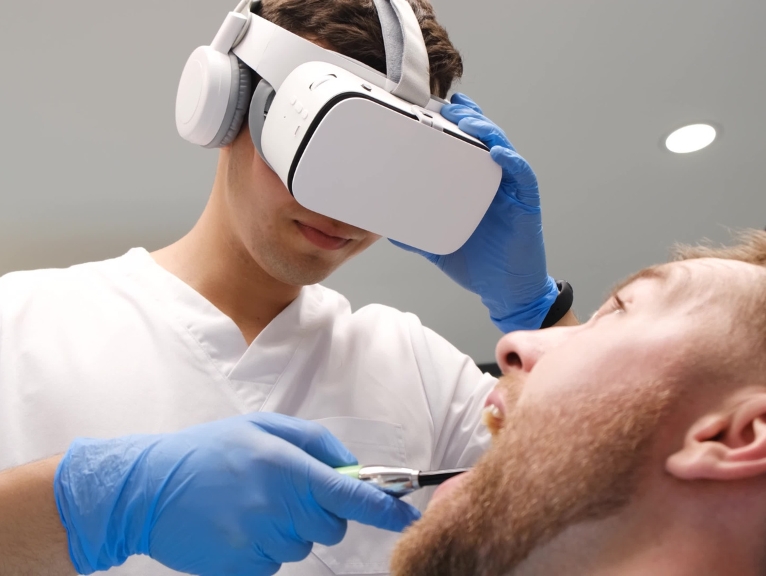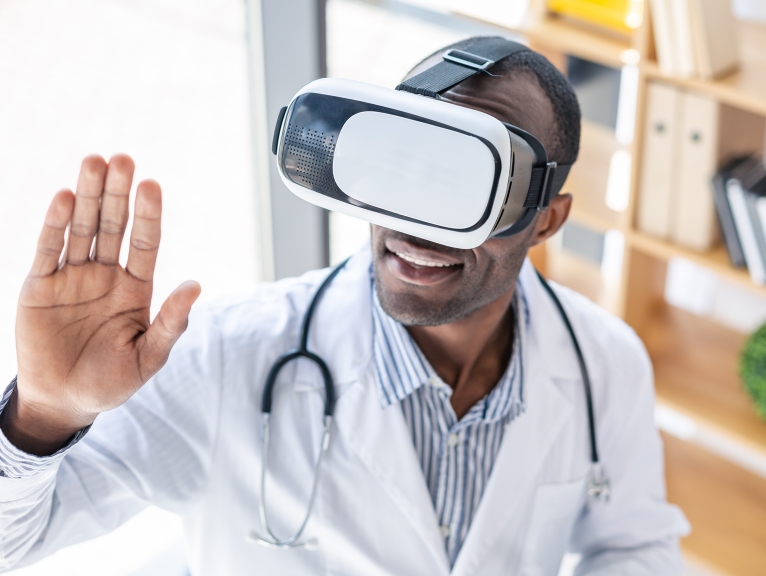
30th December 2024
Virtual Reality and Dental Training
The way we learn and train in dentistry is changing. Virtual Reality (VR) has begun to transform dental training into a much more engaging, hands-on experience. It’s altering the way that dental nurse training takes place, and it could see learners better equipped to master new procedures, as well as the soft skills of patient care.
How is VR Used in Dental Training?
VR in dental training helps to create a more immersive, interactive experience for trainees. If a learner is wearing a VR headset, both the student and the professional can practice techniques in a fully simulated – and therefore safe – environment.
This means that they can work on virtual patients, handle dental tools, and navigate real-life challenges without any risk to actual patients. It’s a very powerful way to help to build muscle memory and to practice complex procedures. What makes it even more useful is the level of repetition. If something goes wrong, there’s no harm done. A student can just restart the process, making skill refinement and technique retention easier.
What Makes VR in Dentistry So Effective?
Immersive Learning
Instead of studying 2D models or textbooks, students can use VR to create a virtual world that’s incredibly lifelike. This 3D environment gives a deeper understanding of dental anatomy and the specific movements a learner might need to perform the task.

Practice Without Risk
No patient wants to be a training tool, and that’s understandable. VR gives learners the chance to get all their mistakes out of the way before they step foot in the clinic. Mistakes in VR don’t matter, but they do teach important lessons. This can build confidence, especially for dental nurse training, where hands-on experience is crucial.
Repetition Builds Competence
Traditional training has its limits. Time with a real patient or a physical practice model is often limited. VR training removes – or at least reduces – these limits. The old adage of ‘practice makes perfect’ rings true here, and repetition is a key part of mastering any skill set. With VR, dental students can practice the same procedure as many times as needed, when they need to.
Real-Time Feedback
VR Training platforms offer instant feedback on techniques. Did you drill too deep? Did you use the wrong angle? Make the wrong movement? You’ll know immediately and can modify your technique accordingly. This rapid feedback loop speeds up learning and builds confidence far more effectively than relying solely on an instructor’s review.
How Can This Benefit Your Practice?
With VR, trainees and nurses can master essential skills faster, which means more practitioners entering the workforce. It also means that those who do are better prepared for the real-life scenarios they’ll be encountering.
It’s cost-effective. Traditional training requires physical models, instructor time, and access to real patients. VR reduces those costs, which can quickly offset the initial investment in VR hardware and software.
Offering VR-based training can also make your practice more attractive to new hires. Trainees want access to the latest tools and often want to learn fast. This makes VR a major selling point. It’s also a great way to keep existing staff engaged and upskilled, which helps with retention.

How is VR Working For Dentistry in the Real World?
University of Portsmouth
The University of Portsmouth has recently invested £5 million into upgrading its dental training facilities. Part of this is incorporating cutting-edge VR technology alongside new phantom head units. This should give students a more immersive, hands-on experience which will bridge the gap between theory and real-world application.
Barts Digital at Queen Mary University of London
At Queen Mary University of London, the Barts Digital program is leading the way in VR in dentistry. The program uses the world’s largest collection of Haptic Dental Trainers. These systems build lifelike physical resistance, so when a student works on a tooth, it actually feels like the real thing.
Northern Ireland Medical and Dental Training Agency (NIMDTA)
The NIMDTA has a dental simulation suite that allows dental trainees to work with haptic-enabled VR machines. These machines offer the tactile feedback of handling actual tools, creating a bridge between simulation and reality.
There’s Still So Much Progress to be Made
We’re only scratching the surface of what VR can do for dental training. As the technology evolves, we’re likely to see more precise simulations, greater integration with AI and machine learning, and systems that offer even more lifelike sensory feedback. The chances are that this will make dental training more efficient, effective, and engaging.
Stay Ahead of the Curve with Curran Dental
Dental training is evolving, and so should your practice. At Curran Dental, we’re here to support every step of your practice’s growth. From cutting-edge dental equipment to bespoke practice design, we’ll help you stay ahead of industry innovations.
With over 20 years of experience in practice design, construction, and equipment, we’re here to make sure your practice looks good and operates at the peak of its potential. Our expert team of designers, builders, and tech specialists make sure that every detail is covered, from the look and feel to the hygiene and workflow.
If you want to find out more about how we can take your practice to the next level, get in touch with us today.
FAQs
What is VR used for in dentistry?
It’s used for training, skill development, patient care, and even planning complex procedures.
How does VR help with dental nurse training?
It lets trainees practice procedures in lifelike scenarios, repeat them as needed, and receive instant feedback.
Will VR replace traditional dental training methods?
No, but it can be used to complement them by providing realistic simulations for scenarios that are hard to replicate with physical models.
Is VR expensive to implement in dental practices?
The initial costs can be high, but prices are coming down, and, when seen as an investment, it can actually save money in the long run.










